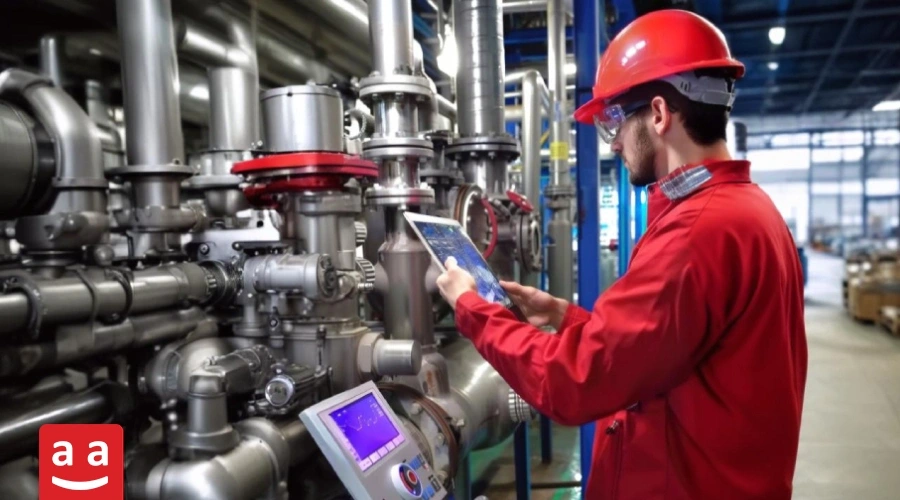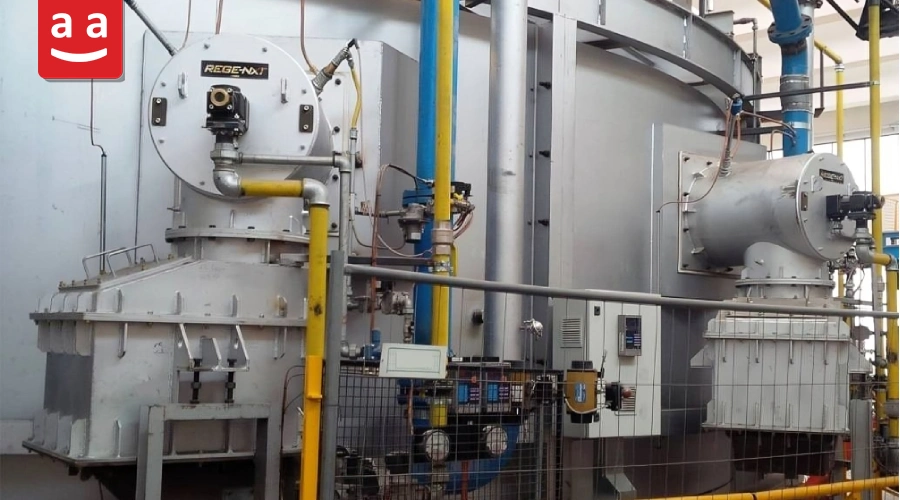As energy demand increases in both residential and industrial settings, heating systems like boilers and hot water packages play a significant role in supplying heat and reducing energy waste. One of the most important criteria for evaluating the operation of these systems is boiler efficiency, which represents the ratio of useful output energy to the input energy of the device. The higher the boiler efficiency, the more optimized the fuel consumption and the lower the operational costs will be.
The purpose of this article is to explore the concept of boiler efficiency, the factors influencing it, and methods for improving design and operation. Furthermore, the impact of equipment coordination and adherence to national and international standards on enhancing boiler efficiency and reducing costs will be discussed.
Definition of Efficiency
Efficiency is defined as the ratio of useful energy output to the total energy input of the device. In other words, efficiency measures the output energy in comparison to the input energy and indicates the operational effectiveness of the device.
To supply the required energy for the process, there are various components such as burners, combustion chambers, hot water transfer pipes, and controllers in the boiler room. Each of these components can affect the system’s overall efficiency. Therefore, for improving the overall efficiency of a heating system, it is recommended to design all the equipment as a unified and coordinated system.


Package Boiler and Boiler Efficiency
This is a set that includes boiler, burner, and control equipment, all placed together. To operate this system, only the connection of water pipes, fuel input, and electrical connections is required. By integrating the boiler, burner, heat recovery equipment, and control systems, parameters such as speed, temperature, and combustion quality can be calculated more accurately, all of which impact the boiler’s efficiency.


Burner and boiler are two main components in industrial heating systems, and their performance is measured using efficiency. A common problem arises when the efficiency of the boiler and burner is not correctly defined separately. Sometimes, the package boiler consists of a burner and boiler from two different manufacturers, and they are not designed to work together.
This mismatch can lead to performance issues. To better understand, imagine installing an engine designed for a specific type of car into another vehicle. Although the car might run, its optimal and reliable performance cannot be guaranteed. As a result, issues may arise over time and identifying the reason can be challenging.
Regarding the boiler and burner, if they come from two different manufacturers, they might supply the required energy, but it is not possible to ensure high efficiency and low emissions with certainty. In case of a malfunction, it would be difficult to pinpoint whether the issue lies with the burner or the boiler manufacturer. Therefore, the coordination and compatibility of the burner and boiler are crucial, as they significantly affect the system’s overall efficiency.
A standard package boiler includes a burner and a boiler that are specifically designed to work together. Factors such as the furnace shape, proper insulation, the amount of excess air for combustion, the air-fuel mixing ratio, and the type of fuel used are all considered from the beginning to ensure the optimal operation of this system.
For a deeper understanding of boilers, their main components, and important factors in choosing and optimizing these systems, read the Comprehensive overview of Industrial Boiler types. This article will help you gain valuable insights into boiler performance and their impact on the efficiency of industrial heating systems.
Factors Affecting Burner Efficiency
The burner is responsible for mixing air and fuel, converting the energy from the fuel into heat, and generating a flame. The design of the burner significantly influences the characteristics of the flame, including temperature, color, and the speed of the combustion products. Some of the most important parameters affecting burner efficiency include the following:
Flame Color and Temperature
The flame produced by the burner must have the appropriate color and temperature for the combustion process to occur effectively and efficiently. In incomplete combustion, the flame is yellow, and carbon monoxide is produced. In contrast, a blue flame in complete combustion indicates full combustion and high efficiency. Furthermore, the flame temperature in complete combustion is higher than in incomplete combustion, because, in incomplete combustion, due to the lack of oxygen, the fuel does not burn completely, and the flame temperature decreases.


Excess Air in Combustion
Excess air in combustion refers to the amount of air that is introduced into the combustion process beyond the theoretical amount required for complete fuel combustion. This excess air prevents incomplete combustion and helps improve combustion efficiency. Proper excess air reduces pollutants like carbon monoxide, but excessive amounts can lead to reduced efficiency and energy waste. Raadman burners by Packman, using AUTOFLAME controllers and CO and O2 sensors, can significantly reduce the amount of excess air in combustion without disrupting the combustion process.


Fuel and Air Mixing Ratio
The burner design must ensure increased turbulence in the fuel and air flow. The higher the turbulence, the better the fuel and air mixing, resulting in more complete combustion and improved combustion efficiency. To achieve better mixing, rotating devices such as diffusers and spinning blades can be used. These devices cause the fuel and air to mix in swirling and vortex paths instead of straight ones. Ultimately, better mixing leads to more complete combustion, enhanced thermal efficiency, and optimal heat transfer. Air velocity also greatly affects the level of turbulence. Hence, in conditions with a high turndown ratio and reduced air supply, achieving proper mixing becomes challenging. In these cases, increasing excess air to achieve the desired turbulence and mixing is necessary. Raadman burners manufactured by Packman Company, featuring precise design and production, create a symmetrical flame with minimal environmental pollutant emissions.


Turndown Ratio
The turndown ratio is defined as the ratio of the maximum burner capacity to its minimum capacity, ensuring that the burner can produce a stable flame and operate with minimal pollutant emissions. A high turndown ratio, along with modular operation, can prevent chiller losses in the boiler caused by the burner pre-purge and post-purge, thereby improving package efficiency. Moreover, a higher turndown ratio increases the lifespan of both the burner and the boiler components. Raadman burners offer a turndown ratio of up to 1:10 for gas fuel and 1:5 for liquid fuel.


Factors Affecting Boiler Efficiency
Proper design, effective insulation, and the implementation of heat exchangers are crucial factors in enhancing boiler efficiency.
Proper Boiler Design
Accurate calculation of the heat transfer surface in boilers and packages in accordance with the burner’s inlet energy, including the combustion chamber, smoke tubes, or water tubes, is essential for optimal boiler efficiency. Improper insulation can result in heat loss, causing energy waste and a decrease in boiler efficiency.
Boiler and Package Insulation
Appropriate insulation of the boiler body plays a significant role in improving boiler efficiency. If the insulation is not correctly applied, heat loss will occur, resulting in energy waste.
Using heat exchangers for energy recovery
Using heat exchangers like economizers can help prevent heat loss of the boiler’s output, thereby enhancing the boiler efficiency.
Efficiency in Compliance with Standards
To assess the efficiency and determine the energy rating of water heating packages, it is essential to refer to the standards that outline the measurement methods. Iranian National Standard No. 21119, which follows the BS-EN 303-3 standard, is specifically designed for water heating packages with forced draft burners. Furthermore, national standards 4472 and 3-21119 are used to measure the energy of water heating packages in Iran. In these standards, the boiler is tested along with the burner recommended by the manufacturer, and all evaluations are carried out as a complete package.
Efficiency Testing Cycle for Water Heating Packages
In accordance with Iranian National Standard 4472 and BS-EN 303-3, to measure the efficiency of water heating packages, hot water from the boiler is transferred to the heat exchanger by a pump. After the temperature decreases and the weight is measured, the water is returned to the boiler. Equipment such as cooling towers or water tanks are used to cool the water in the heat exchanger. During this process, expansion and feed sources and thermometers are installed at the boiler’s inlet and outlet points. This test requires specific equipment for measuring temperature, pressure, water flow rate, gas consumption volume, and environmental conditions.


High Efficiency and Cost Reduction: The Importance of Defining Efficiency as a Package
This article addresses the importance of defining the efficiency of water and steam boilers as a package. Determining boiler efficiency in an integrated and coordinated manner helps reduce energy consumption and operational costs. A package boiler, due to the coordinated combination of the boiler, burner, and control equipment, delivers superior overall efficiency compared to standalone boilers and burners. Furthermore, using advanced control systems such as AutoFlame and implementing national and international standards like Iranian National Standard 21119 and BS-EN 303-3 help improve boiler efficiency and reduce environmental impacts. In conclusion, defining efficiency as a package is an effective approach to improving productivity and minimizing the environmental effects of boilers, which is crucial for the optimal use of resources and energy cost management.





